Welcome to Matrix Education
To ensure we are showing you the most relevant content, please select your location below.
Select a year to see courses
Learn online or on-campus during the term or school holidays
Learn online or on-campus during the term or school holidays
Learn online or on-campus during the term or school holidays
Learn online or on-campus during the term or school holidays
Learn online or on-campus during the term or school holidays
Learn online or on-campus during the term or school holidays
Learn online or on-campus during the term or school holidays
Get HSC exam ready in just a week
Select a year to see available courses
Science guides to help you get ahead
Science guides to help you get ahead
Learn how to break down an assessment notification to fully understand what you need to go to get your next A grade!

Join 75,893 students who already have a head start.
"*" indicates required fields
Related courses
Often, High School students quickly skim their assessment notifications and never touch them again. This is a huge mistake! Assessment notifications are important tools that can help you better prepare for your assessment tasks and achieve a high grade. To help you out, in this article, we will show you how to use your assessment notification to ace your next assessment task!
Schools are required to give you an assessment notification before every formal assessment task. Normally, this is done at least 2 weeks before your assessment date.
This notification entails everything you need to know about your assessments. NESA outlines that formal assessment notifications must include:
Here is an example of an assessment notification:
Many students struggle with assessments because they’re not entirely sure what they need to do. This is because they often overlook the importance of the assessment notification or they are confused about the contents of the notification and are too embarrassed to ask for help. This is why we will help you break down assessment notifications in this article!
Understanding assessment notifications is crucial to achieving a high grade!
It contains detailed instructions about what the task entails and shows you what you need to do to achieve an A grade, B grade or C grade.
The notification also goes through syllabus outcomes that you will be assessed in the task. So, it is a good idea to familiarise yourself with these outcomes and ensure that you are confident in all of them. If there are some confusing points or weaknesses, then use your preparation time to improve these outcomes.
Learn about Matrix English course now.
We know reading assessment notifications can get a little confusing and confronting, especially with all the challenging language used in syllabus dot points and the marking criteria. However, it doesn’t have to be that way!
Following the steps below will help you break down the assessment notification into manageable chunks of information. So, let’s get into it!
Students tend to overlook the importance of assessment notifications, so they usually just skim over it. However, it is crucial that the first thing you need to do is to read the assessment notification wholly!
It is best to read it over 2-3 times just to make sure you understand everything.
In your first reading, you should simply read. Try to understand what this assessment task entails. This means that you shouldn’t take out a highlighter or pen for this step.
In your second reading, you can use a highlighter or a pen to highlight important information like date, and time limit, and keywords in the questions and marking criteria. We will go through these in more detail in the following steps, so don’t stress!
Your third reading is all about consolidating everything. Take this time to ensure that everything makes sense to you! If it doesn’t, ask your teachers or your friends to help you clarify things. You don’t want to be confused about anything before you start working on your assessment tasks because this will negatively impact your work.
As we mentioned earlier, in your second reading you should begin to highlight important information about your assessment task.
Assessment notifications will include the following if applicable :
Let’s take a closer look at this section of the assessment notification and see if you can spot the key information:
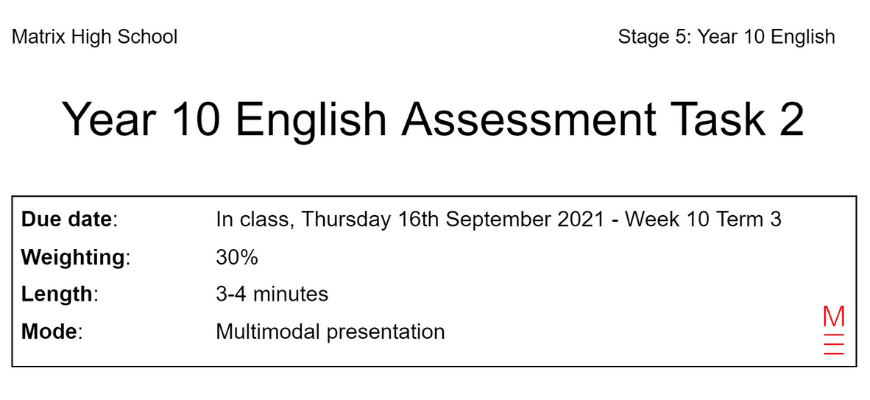
Let’s check to see if you’re right! We have underlined the important information in the image below.
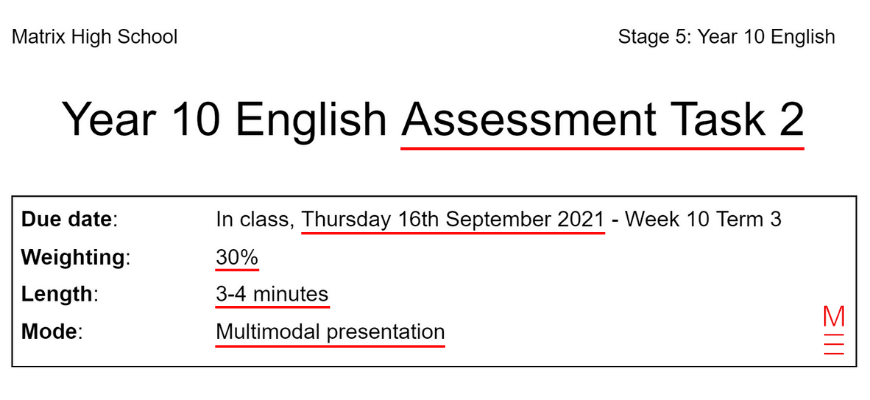
It is a good idea to jot down the date and name of the task into your school planners and calendars so you don’t forget when it is due! You can also use refer to the weighting of the assessment to determine what mark you need to get for this task to aim for a particular grade.
If you want to learn how to use your school diaries, check out our article: How to Use a Study Diary to Ace High School.
All assessment notifications should include a list of syllabus dot points.
You can only be assessed on what is listed in the NESA syllabus.
So, it is a good idea to familiarise yourself with the syllabus outcomes on your assessment notifications to know exactly what skills and knowledge you need to know for this task.
1. Highlight the verbs and keywords
Let’s take a look at this Syllabus outcomes section of an assessment notification.
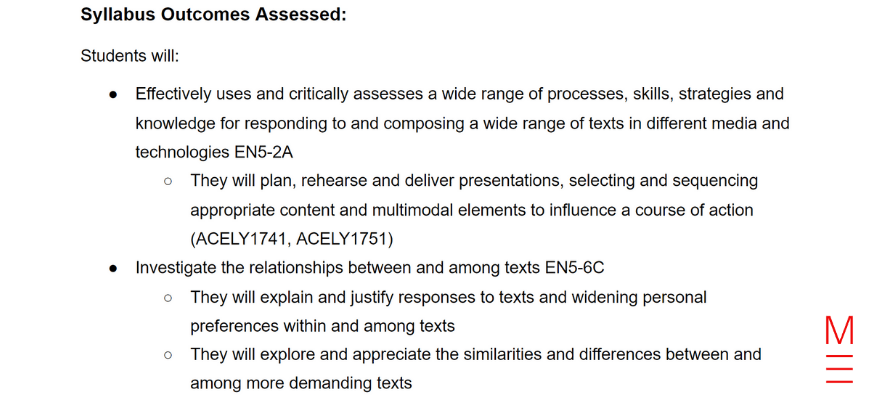
If you want to check out the syllabus, you can find it here: NESA Stage 5 English syllabus.
Often syllabus outcomes cover both skills and knowledge.
In the above example, the first major dot point refers to a skill that you need to know, and the second refers to the knowledge you need to showcase in the assessment.
To break down these outcomes, highlight the action verbs in one colour and the keywords in another colour:
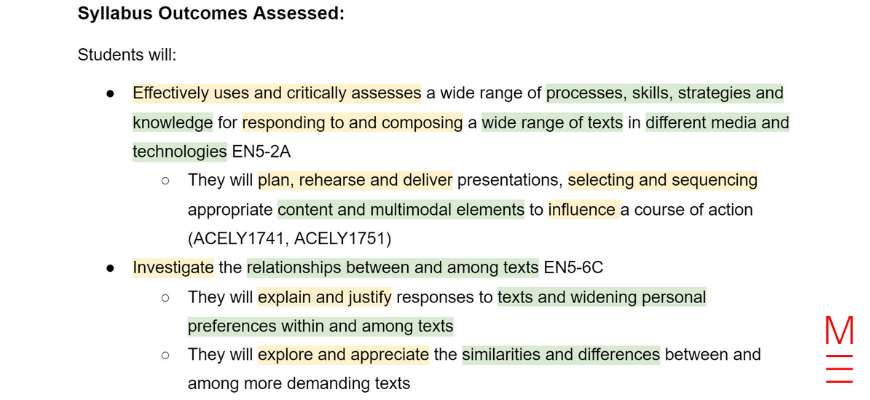
This will help you figure out what you need to do and what knowledge you need for the assessment task.
Note: If you are confused about some of the action verbs, check out our How to Response to NESA Key Words article to learn what it means and how to respond to them.
2. Reword the dot points in simple terms
Even after highlighting the keywords in the syllabus outcomes, you might still be confused about what they mean! That’s okay. Let’s break it down even more.
To do this, you should:
Here is an example of the summarised syllabus outcomes:
3. Rate your confidence levels for each dot point
Now that you’ve figured this out, you should rate how confident you are at tackling these points. Rate yourself a number out of 5 for each of these outcomes; 1 for least confident and 5 for most confident.
Doing this will identify your strengths and weaknesses to help you better prepare for your assessment.
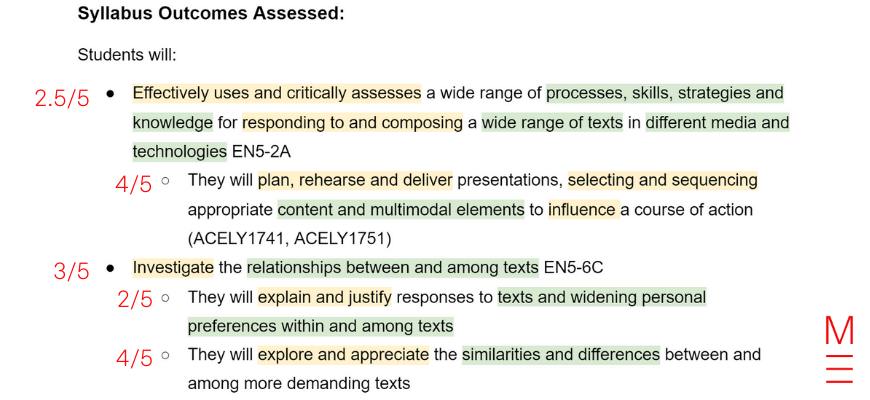
Use your preparation time to strengthen these weaknesses and consolidate your strengths. Create a study plan to do this!
After you’ve rated the syllabus outcomes to figure your strengths and weaknesses, it is time to break down your question or given task.
Most students don’t take the time to really break down the provided question.
Instead, they jump straight into their assessment task which hinders their mark because they might miss important notes on the assessment notification.
So, let’s learn how to really break down your question to fully understand how to complete your assessment task.
Note: Some in-class assessment notifications won’t provide you with a question/task. If so, you can skip this step.
1. Understand the type of assessment
You can be asked to write an essay or an imaginative response, present a multimodal presentation or a play adaptation, or create a radio podcast or costume design. Each of these modes of assessment will require you to approach the task differently.
For instance, submitting an essay when your teacher is asking for an imaginative response is enough to make you fail the task.
So, you must know exactly what kind of assessment you need to do. Often, this will be clearly written in the key information or the question itself.
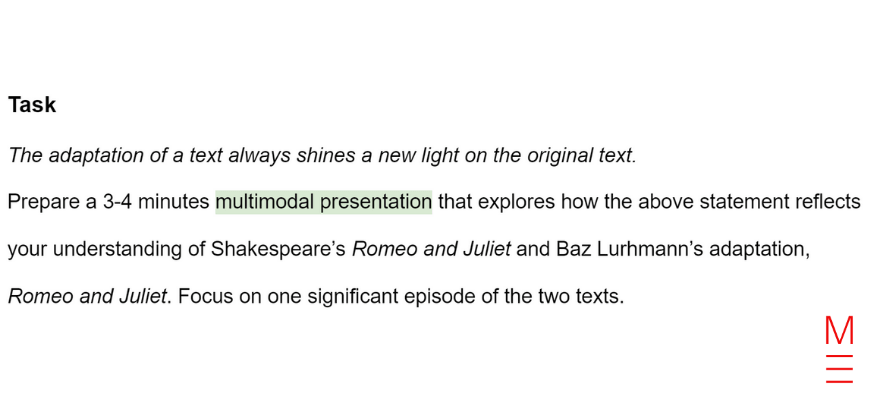
2. Highlight action words
Evaluate, analyse, explore, discuss, identify… These action verbs all require you to present the information in different ways.
For instance, ‘evaluate’ requires you to determine the value or quality of something, whereas ‘discuss’ requires you to provide points for and against a topic.
So, highlight the action keywords and define what it means.

Let’s quickly summarise some important action keywords that you might come across in High School:
| Action verb | What you need to do |
| Assess | Make a judgement of value, quality, outcome, results or size |
| Analyse | Identify components and relationships between them, then draw out and relate the implications |
| Compare | Show how things are different or similar to each other |
| Describe | Provide characteristics and features |
| Discuss | Identify issues and provide points for and/or against |
| Explore | Inquire into a topic in detail |
| Evaluate | Provide a judgement of quality or value |
| Summarise | Give a brief statement of the main ideas |
If you need help figuring out what the word requires you to do, take a look at our How to Respond to NESA Key Words to learn how to respond to different action words! We go through a list of common action verbs and break it down in more detail.
3. Identify the content-related keywords
Content related keywords indicate what you need to discuss. They often refer to main ideas, issues, or topics that you need to discuss.
You must centre your assessment around these keywords to fully answer the question given to you.
For instance, the question below requires you to focus on the “new light” that adaptations shine on original texts.

4. Highlight the scope/limiting words
It will be impossible to talk about everything you know about a particular topic. This is where scoping words come in.
Scoping words help you limit your discussion.
For instance, you can be asked to focus on a particular text or a specific scene in a text.
In the example below, the scoping words are the two identified texts and the “one episode” limitation.

5. Define the above keywords
Now that you’ve identified all of the important keywords, it is time to define them. There is no point in know what the keywords are without knowing what they mean.
Use Google or a dictionary to search up words that you are unsure about and/or find synonyms for them.
You should also try to find synonyms for words that you already understand to help you write your assessment task without being too repetitive.
Now, let’s define some keywords and key phrases from our example question to show you how it’s done:
6. Rewrite the question in your own words
Sometimes rewriting a question is the best way to understand it. When you do this, use synonyms or phrases to explain what the question requires you to do.
Let’s rewrite the statement in the question to make it easier to understand:
“An adaptation of the text (Baz Lurhmann’s Romeo and Juliet) can provide a new perspective on the original text (Shakespeare’s Romeo and Juliet)”
The marking criteria contain vital information that will help you boost your B grade task to an A grade.
Most students don’t bother looking at the marking criteria because all the points in each band look very similar to each other, especially at a quick glance.
However, when you examine it closely, you will notice the differences between the different grades/bands.
Let’s break down these marking criteria together:
1. Highlight the action words in one colour
As we mentioned earlier, action words are verbs that indicate how you should write your assessment. You should highlight the action words to see what you need to do.
If you are aiming for a certain band, ensure that you are following the action verb because it can distinguish you from a C grade to an A grade. In the above example, a C grade requires you to “explore” the statement effectively, whereas an A and B grade requires you to “evaluate” the statement.
2. Highlight the content keywords in another colour
Now, let’s highlight the content keywords in another colour. The content keywords will help you figure out what you need to write about.
As we mentioned earlier, content keywords help you figure out the topic or information you need to discuss in your work.
Here, let’s examine this example of an A-grade marking criterium:
In this example, you can see that you need to have:
3. Go through each band/grade and compare the similarities and differences
Once you’ve highlighted the action words and content keywords, it is time to compare the similarities and differences between the different grades. This is especially helpful if you are aiming for a particular grade as you will know what you need to do to boost your mark to the next level.
So, compare two bands at a time and underline the differences between the two criteria.
Here is an example:
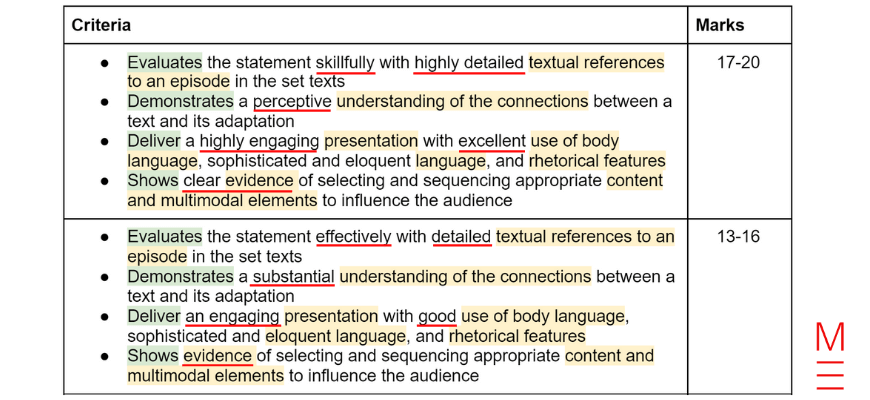
Let’s compare this in a table to see the differences more clearly:
| A-grade | B-grade |
|
|
Continue doing this for the B and C grades too to ensure that you are aiming high!
Written by Matrix English Team
The Matrix English Team are tutors and teachers with a passion for English and a dedication to seeing Matrix Students achieving their academic goals.© Matrix Education and www.matrix.edu.au, 2023. Unauthorised use and/or duplication of this material without express and written permission from this site’s author and/or owner is strictly prohibited. Excerpts and links may be used, provided that full and clear credit is given to Matrix Education and www.matrix.edu.au with appropriate and specific direction to the original content.